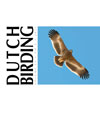Dutch Birding volume 33 (2011) no 3

Green Heron at Amsterdam and Zaandam in 2006-09
One of the most peculiar rarity records ever in the Netherlands concerns a Green Heron Butorides virescens first seen near De Nieuwe Meer, Amsterdam, Noord-Holland, on 25 April 2006. It remained at freshwater marshes and canals at Amsterdam until 24 June and at a different site c 10 km north on 14-30 September 2006, after which, amazingly, it was rediscovered on 16 December 2006 more than 1000 km south near the Mediterranean Sea shore at Berre-l'Étang, Bouches-du-Rhône, France. In May 2007, it left its French wintering site to turn up again at Amsterdam three weeks later where it was seen on several days between 31 May and 27 June (at the same site as in September 2006) after which it was also watched at nearby Zaandam on 18 July. After a second winter at Berre, there were no sightings at Amsterdam or Zaandam in 2008 but it is likely that it stayed at an inaccessible site since, after a third winter at Berre, it was seen again at Zaandam from 25 May to 19 July 2009. The wintering site used for three consecutive years at Berre was 30 km east of Camargue and a few kilometres north of Marseille airport, from 16 December (perhaps 5 November) 2006 to 2 May 2007, 31 October 2007 to 4 May 2008 and 8 November 2008 to 6 May 2009. It did not return at Berre in the winters of 2009/10 and 2010/11 nor was it found at Amsterdam or Zaandam in the summer of 2010.
The bird was in juvenile plumage when first seen at Amsterdam in April 2006. That explains why, initially, there were doubts about its (sub)specific identification although the often-concealed reddish brown hindneck fitted Green Heron rather than any Striated Heron B striata. When it was rediscovered in mid-September 2006, it was unequivocally a Green Heron as it had adult body-feathers and wing-coverts, including obvious reddish-brown on neck and breast, the single variable to separate Green from all Striated Herons.
The bird's juvenile plumage in second calendar-year and its confiding behaviour at an unusual site in an unusual season also raised doubts about its origin. However, it became clear that there was no evidence of any Green Heron in captivity in the Netherlands or elsewhere in Europe (the only Butorides species found was Striated Heron). Also, the plumage and the bare parts did not show any anomalies indicating a ship-assisted passage or captive origin, and it is well documented that wild birds in the USA may get used to people, becoming remarkably unwary, and this has also been the case in a few transatlantic vagrants.
The bird's migrating behaviour, leaving the Netherlands in late September or early October and arriving in mediterranean France from late October, fits the migratory North American subspecies. In this respect, it is worth considering that the temperatures in the Netherlands in September-October 2006-08 were still far too high to force non-migratory birds out. Moreover, the fact that the bird left its French wintering site as late as the first week of May indicates an original provenance from the northernmost populations in North America, where the species turns up in spring much later than in the south, for instance, starting to nest from late April in New York, USA, or from early May in Ontario, Canada.
It was argued that photographs from April showed down filaments ('filoplumes') on the vent, indicating that the bird had fledged only a month or so earlier, a view adopted by the French rarities committee. However, the nature of these feathers is questioned as the breeding phenology in the entire range of Green Heron supports the idea that in 2006 the bird could only be in its second calendar-year. As far as known, in Latin America and the Caribbean, egg-laying takes place from March to July, with just one report as early as February-March (Veracruz, Mexico); in the southernmost USA, it starts from late March onwards; and in Bermuda and northern parts of its range, it is from late April to mid-July. It takes at least two months from egg-laying to fledging. If there were any captive breeders in Europe, it is unlikely that these would start breeding months earlier than their wild congeners. Moreover, the central crown-feathers were either moulted or abraded as they did not show the brown fringes obvious in fresh juveniles. Some visible wear of mantle-feathers and scapulars, which in fresh juvenile plumage have broader brown fringes, and an obvious abrasion of the lower scapulars also show that the plumage was not as fresh as one would expect for a recently fledged bird. It should be reminded that the visibility of feather wear is not due to a linear process in time but hidden until the feather's structure is damaged to such an extent that its integrity is lost. This may explain why, generally, herons do not show much plumage wear. Besides, the wear of its juvenile plumage was not regarded as much different from other birds, which remain in juvenile plumage during winter as has been demonstrated in Lesser Black-backed Gull Larus fuscus and other large white-headed gulls. In September and December 2006, the bird had moulted into an adult-like plumage with adult body-feathers and wing-coverts. It still had at least a number of juvenile remiges as late as June 2007, in its third calendar-year.
To understand the reasons why a post-juvenile moult can be postponed for so long, one may look at the link between length of photoperiods (hours of daylight) and moult. This mechanism appears to be directed by the hormone prolactin. The secretion of this hormone is proportional to photoperiods, and moult starts when the level of prolactin begins to decrease. During periods with short photoperiods, no prolactin is produced and, without prolactin, moult is arrested. As a result, in Europe, a Green Heron should not undergo any substantial moult from late October onwards, despite the mild climate. Consequently, a heron fledged in late September, crossing the Atlantic and wintering in southern France before moving north to the Netherlands will not have had a period of sufficient daylight to start its moult. It should be noted that southern France is situated at the same latitude as the northern breeding range of this species, and much further north than its northernmost wintering range. This scenario fits the bird's plumage and moult well while the alternative, a bird that crossed the Atlantic in spring from the Caribbean, does not offer an explanation. During its first summer, the bird may have had too little time for a complete moult because of breeding intentions, and the juvenile remiges remaining into its third calendar-year can again be explained by the photoperiod principle as this moult normally occurs at a much more southerly location with longer photoperiods than in southern France.
Up to 2010, there are 22 records for the WP region, of which 10 in the Azores, seven in Britain and two in Iceland. Apart from the 'Amsterdam bird', which has been accepted as the first for the Netherlands (but not (yet) as the second for France), most records date from mid-August to November with additional ones in spring on 1 April 1994 (France) and 28 May-24 June 2004 (Iceland).
Arnoud B van den Berg, Duinlustparkweg 98, 2082 EG Santpoort-Zuid, Nederland
(arnoud.b.vandenberg gmail.com)
gmail.com)
terug






